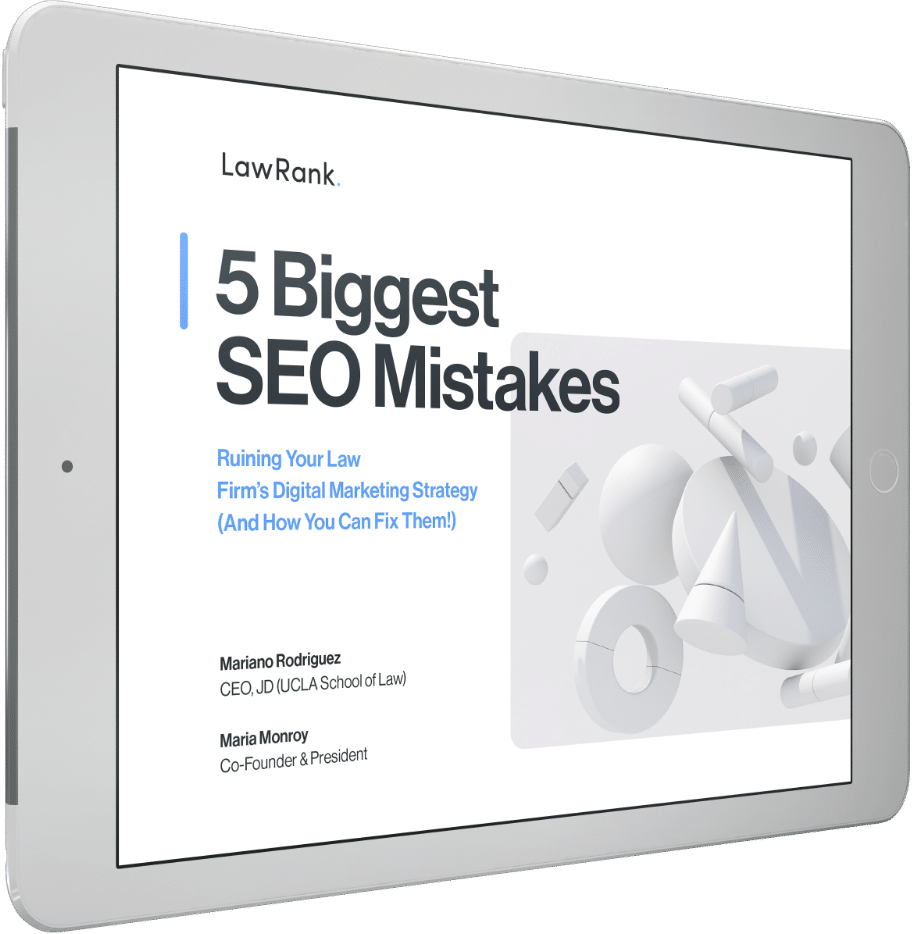
Content is King – It’s Really What Matters Most
Content – what’s found on your website – should be the cornerstone of your law firm SEO campaign. Content is what will drive the success of your law firm’s digital marketing efforts. We consider content to be the most important Google ranking factor.
To really optimize your website, you’ll need content that is:
- Compelling
- Relevant to your user’s inquiries
- Easy to read
Here, we’ll break down everything you need to know about content to optimize your campaign.
What is Law Firm Content Marketing?
Put simply, content marketing is the process of publishing high-quality content that attracts and engages your audience. It’s about creating enough value for your audience that they actively seek it out and can’t stop reading once they find it.
Content includes both your core website pages and more dynamic content, like blog posts and whitepapers.
The object is to publish enough content in your field that you become a credible advisor. Building this trust will motivate your audience to look to you when they need help from an attorney.
That’s why, according to one survey, content marketing ranks as the most effective digital marketing tactic for lawyers.
What Kind of Content Do I Need to Maximize My Attorney SEO Campaign?
First, it’s important to know what content is.
Content refers to anything that can be read, viewed, seen, or digested by web users. If you’ve put it on your site to convey information to the user, it’s content.
For attorney websites, the most important types of content typically include:
- Practice area pages
- Blogs
- Resource pages
- Longform content
- Images
- Infographics, and
- Videos.
We’ll break down these different types of content, why they’re important, and how to create them.
Practice Area Pages
Practice area pages, or PAs, are where you sell your legal services. These are considered “evergreen pages.”
What makes a page evergreen? It’s content that is fresh, relevant, and informative for years to come after it’s published. It’s also easy to find on your firm’s website – it doesn’t get pushed down a long blog roll as new content is published.
Let’s say someone is injured in a motorcycle accident just outside of Tampa, FL. When they go to search for a lawyer, they might search for “Tampa personal injury lawyer,” or they might search for “Tampa motorcycle accident lawyer.”
If this is a type of personal injury case you handle, you’ll need to have a dedicated page for motorcycle accidents in Tampa. More specifically, you’ll need to have a practice area page dedicated to motorcycle accidents.
Your practice area page should:
- Provide potential clients with relevant information about motorcycle accidents
- Explain laws and rules in your state that might affect their legal rights and injury claim
- Sell your law firm and convince the user that they should call you for help getting compensation.
Think of practice area pages as your sales pitch – an opportunity to speak directly to potential clients and get them to call you for help with a specific problem.
Pro Tip: Practice area pages are really written to target searches for short-tail keywords and broad inquiries.
Blogs
If you run a law firm, have a website, and care about ranking, you need to be blogging.

Not blogging means lost opportunities when it comes to ranking, traffic, leads, and conversions. Small businesses that blog get 55% more traffic and 126% more leads (that are 6x more likely to convert) than businesses that don’t blog.
Blogging is all about growing traffic and increasing your brand’s visibility. Blogs aren’t necessarily written for people who are sitting down to search for an attorney. Blogs aren’t intended to really sell your legal services.
Rather, they’re written to capture traffic for topics, questions, and content that have a high search volume. If you can write great blog content on high traffic topics, then you’ll be in a great position to rank and drive web traffic to your firm’s website.
Here, you have the chance to write about industry topics, frequently asked questions, and more. Keywords about how to find the right lawyer or how much a lawyer should cost are perfect topics for an awareness- and credibility-building blog post.
The more traffic you have, and the longer users stick around to see what you have to offer, the better. Both are positive ranking signals that will carry a lot of weight when Google determines where your site should rank when people are searching for information related to your practice.
Pro Tip: Blogs are your primary tool for capturing long-tail keywords and directing traffic to your firm’s website.
Resource Pages
Resource pages are a hybrid – not quite a PA and not quite a blog. Resource pages are evergreen, designed to capture a lot of traffic, and aren’t overly salesy. They’re really intended to provide more detailed and in-depth information than a standard Practice Area page.
Well-crafted resource pages can be a great tool for an aggressive internal linking campaign. These pages allow you to seamlessly embed internal links to other content on your website, increasing users’ ability to interact with your content.
For instance, let’s say you practice personal injury law. Your practice area pages, generally speaking, should at least acknowledge things like “negligence,” “contributory negligence,” “statutes of limitations,” “causation,” and “burdens of proof.”
Even if you don’t go into great detail about these things, a good personal injury practice area page will touch upon them.
Resource pages give you the opportunity to explain what these different things mean in more depth and discuss how they can affect a personal injury case. It also gives you the opportunity to encourage your readers to click through to a new page and, in turn, spend more time on your website.
The more time a user spends, the more positive the signal to Google. This is the essence of an internal linking campaign.
Think about Wikipedia. You might start out reading about bitcoin out of curiosity, and then, before you know it, you’re learning all about wildlife that’s native to the Everglades because you clicked on so many internal links to learn more about some term highlighted in the text.
Think about how long you could get people to stick around your firm’s website simply by giving them information about aspects of their legal cases that they’re interested in learning more about.
Again, the longer someone sticks around on your site – the longer they dwell – the better. This sends positive signals to Google – and it helps convince a potential client that you’re the right person to represent them because you’re an authority on cases just like theirs.
Longform Content
Typically “gated” behind a sign-up page, Longform content includes ebooks and whitepapers. This content offers an in-depth exploration of a particular topic, with the landing page serving as an SEO-optimized gateway.
Longform content can increase dwell time on your website by going into greater detail about a topic than your blogs or resource pages – and by connecting the topic to other related content on your website. Longform content has authority in the eyes of Google, as well, because longer content tends to demonstrate authority and expertise on a topic.
Images
Content isn’t just text on the page – it’s everything that you put there for people to see. That includes stock images and pictures of your firm’s attorneys and staff. You can use images on your web pages to make them more visually appealing and enhance its UX.
However, images don’t just make your website more visually appealing – they also help to draw traffic.
A study by BrightLocal found that people are 60% more likely to click on a local search result and 23% more likely to contact a company when their page has images. Additional research suggests that you can get 94% more views by putting images on your firm’s webpage (when compared to firms without pictures).
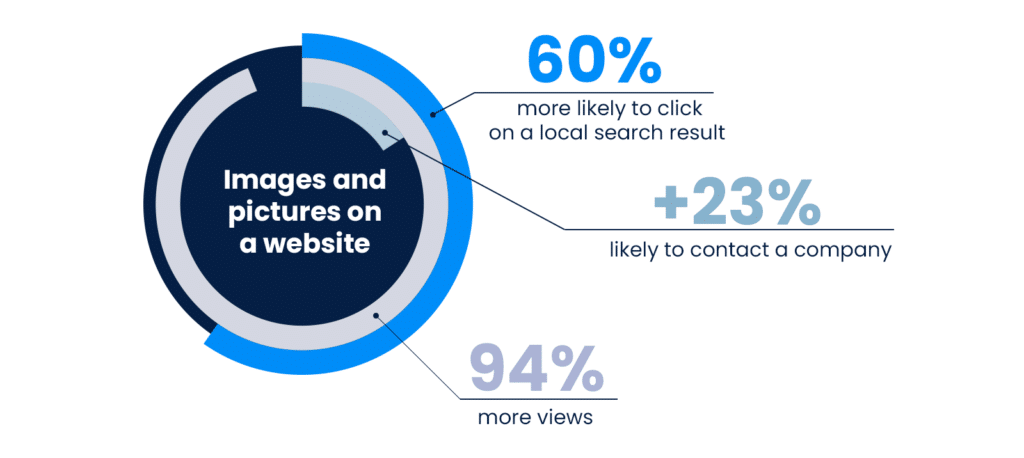
Infographics
A lot of people – nearly two-thirds of the population – are visual learners. So, it’s really important to give users information that’s easier to digest than words on a page. Infographics are images that relay information in an easy-to-understand way. Think graphs, flowcharts, and diagrams.
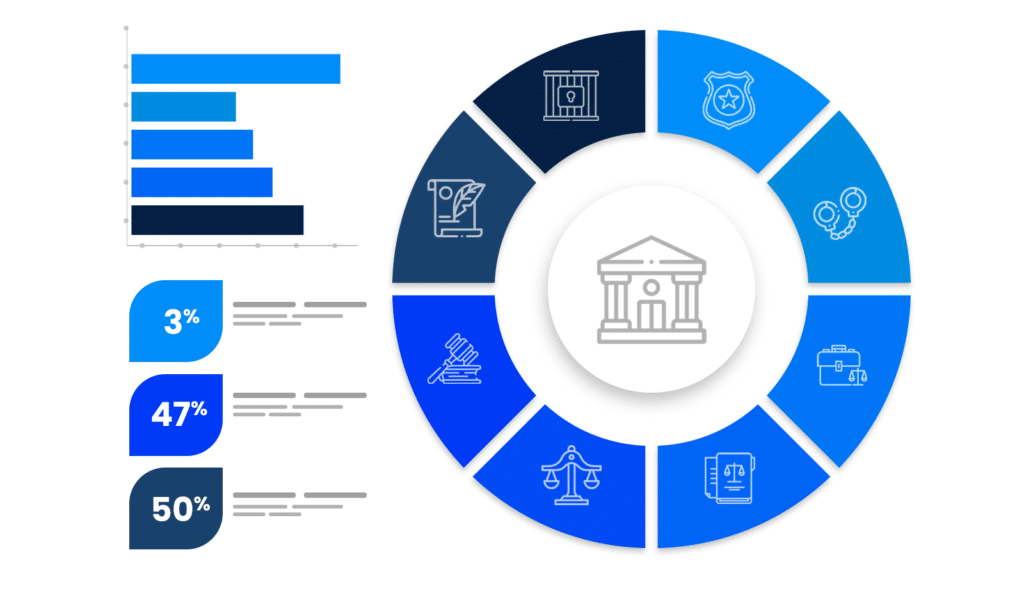
When you’re presenting complex information to a lay audience, infographics can help you deliver it in a more accessible and appealing way. When done correctly, infographics can serve as a great mechanism for gaining backlinks.
Videos
In today’s digital age, nothing beats a video. Many people – especially young people – would rather watch a video than read a book or web article. Statistics indicate that you can get a 41% boost in clicks just by integrating a video (or two or three) on your firm’s site.
Google seems to prefer websites that have videos, too. As Google crawls your website and analyzes page quality, it’s looking for a lot of different things – including a variety of multimedia elements to enhance the user experience.
So, it makes sense to supplement your content with videos if you can.
What kind of videos help?
Branded Introduction Video: Show potential clients who you are, what you do, and how you’ve helped others.
Video Series: Create a series of videos discussing important topics related to your practice area.
Videos aren’t just a great way to provide people with high-quality content and enhance the user experience. Great videos can be invaluable in a link building campaign – getting your site tons of backlinks from a multitude of referring domains.
Pages that have three distinct types of multimedia – lists, images, and videos – are more likely to have a greater number of backlinks and referring domains than sites that do not.
According to Moz, people are more likely to view your page when it contains videos and more likely to link to it as well.
Often, these backlinks are from authoritative, trustworthy, and/or reputable websites – which factors highly in Google’s rank evaluation process.
Optimizing Web Content For Law Firms
Now that you know the types of content that you should aim for, it’s important to understand techniques for optimizing what you put on the page.
Aim for longer content: Content above 1,500 words consistently outperforms shorter alternatives in Google rankings.
Create topic clusters: That’s a primary “pillar page” on a core keyword along with plenty of shorter content around the various related subcategories.
For instance, if you run a personal injury law firm, you’ll have a primary or “core” practice area page for car accidents. Then, it’s smart to create supporting content that expands on the topic – examples might include “highway accidents,” “intersection accidents,” “do I need a lawyer if I’m in a hit and run,” or “local car accident statistics.”

Let your core practice area page speak to the issue broadly and answer the most pressing questions your potential clients have. Flesh out the information you provide by creating informative supplemental practice area pages.
This approach can increase your site’s authority, improve the user experience, and increase the time a person spends reading through your content.
Statistics: Keep your firm’s website content fresh with updated statistics that are geographically and informationally relevant.
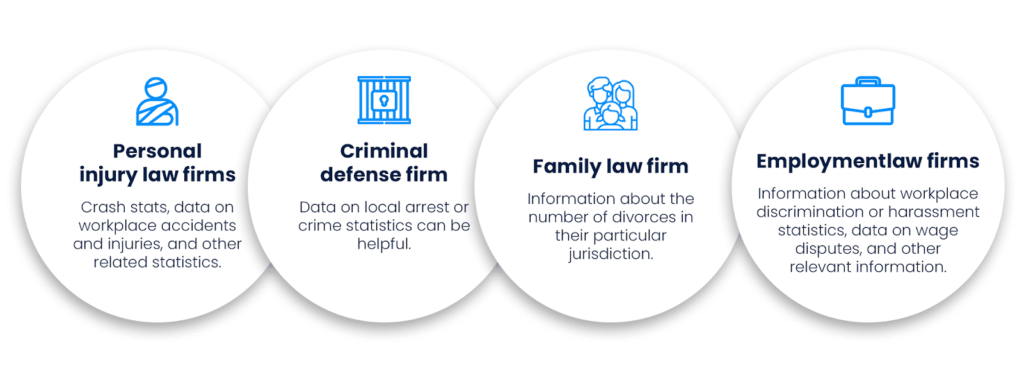
- Personal injury law firms should consider adding crash stats, data on workplace accidents and injuries, and other related statistics.
- If you’re a criminal defense firm, data on local arrest or crime statistics can be helpful.
- Family law firms could incorporate information about the number of divorces in their particular jurisdiction.
- Employment law firms can easily weave in information about workplace discrimination or harassment statistics, data on wage disputes, and other relevant information.
Google will give law firms that keep their statistics up to date a boost in the rankings. After all, users will be more interested in the most recent data available. Give them what they’re looking for, and Google will be more likely to move you closer to the top.
Keywords: Make sure your PAs contain the keywords that are driving searches. See our section on keyword research to get a better idea of how to find the right keywords for your law firm’s website.
Use Headings to Create a Clear Outline: People don’t read online, they scan. As such, you should create a clear outline using H tags. Because most people ask questions when they search, it’s a great idea to make an outline of the questions that you intend to answer.
For example, if you search for “NYC car accident lawyer” you’ll see our client at the top: Rosenbaum & Rosenbaum. Using Browseo, you can quickly see the headings used. These headings are the “outline” of the page.
Repeating this process for the top 5 ranking pages should give you a clear idea of what content your page needs to include to rank.
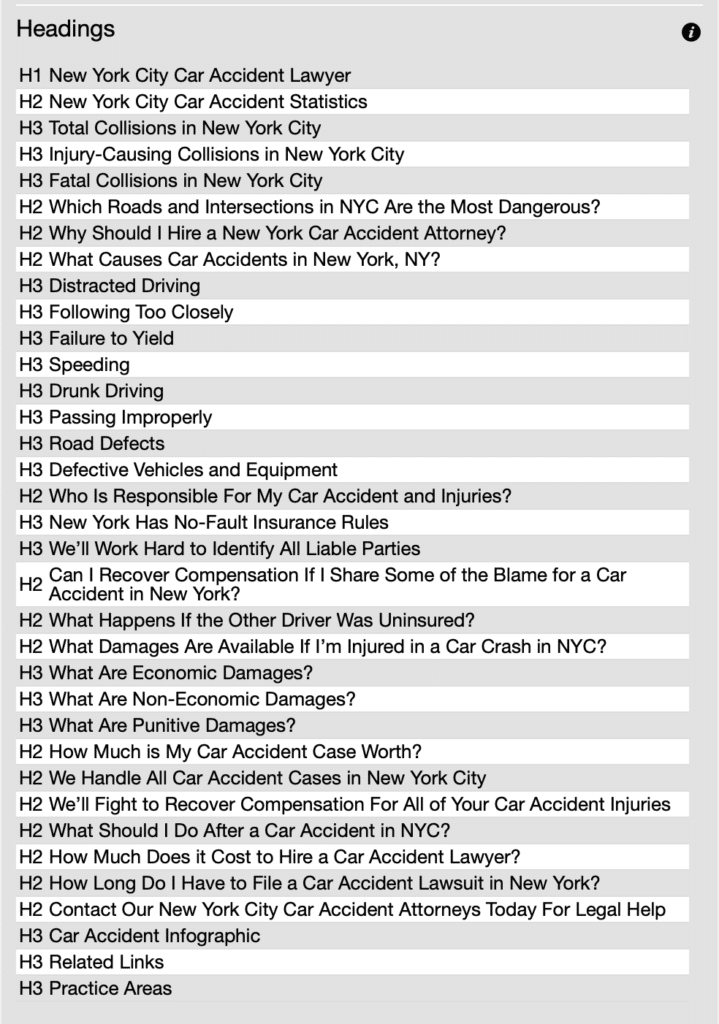
Readability: Content needs to be written for the everyday person. The average American reads a 7th- or 8th-grade level – or that of a 12, 13, or 14 year old. So, in order to make sure that your potential clients are able to understand the information you’re providing, it needs to be written at no higher than an 8th-grade level.
Accessibility: It’s not just about putting good information on a page. It’s about putting good information on a page in a way that’s easily accessible to the reader. Think about when you read something online. You probably do more scanning than actual reading – especially if there’s certain information you’re looking for.
That’s why you should aim to publish your content in a way that’s easy to scan using:
- Clear, informative headers
- Short paragraphs
- Bulleted lists
- Pictures/infographics
The more accessible your content is, the better it’ll perform – both in terms of ranking and converting.
Embrace Questions: Anywhere between 8% and 27% of all web searches are phrased as questions. So, why not pose and answer those questions right on your law firm’s site? If someone wants to know “What is My Personal Injury Case Worth?,” you should have that specific question on your site – followed by a very precise and helpful answer.
Make the most of this strategy by using Headers to pose the question and content underneath the Header to answer it. After all, Google places a lot of emphasis on what’s in your H2 and H3 tags. Send signals to Google that you have the information users are looking for. You might even get a featured snippet out of it.
Featured Snippets: Featured snippets are selections of text in an answer box that are automatically displayed on a Google SERP. It’s content that Google believes best addresses a user’s inquiry. Roughly 12% of all searches return with a featured snippet.
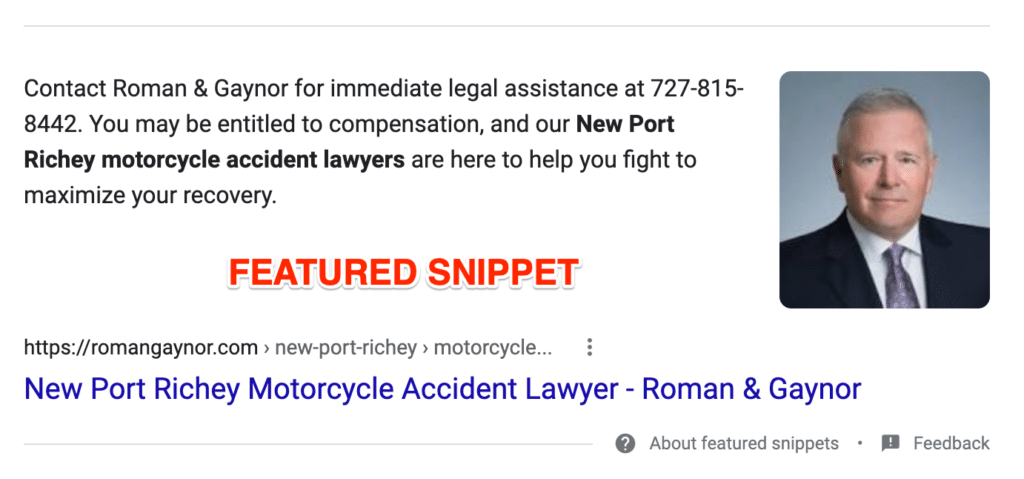
If your text is selected as a featured snippet, there’s a 90% chance that the corresponding page will rank in the top five results. And, if someone does a voice search, 40.7% of the time their query will be answered with a featured snippet.
There’s no guarantee that your text will be featured in the answer box – but simply aiming to write the best content will undoubtedly give your website a boost. Best case scenario, you’re featured above the organic results and generating authority for your brand.
Double Check Your Keywords: You have keywords – but did you incorporate them into your content? There are a multitude of tools out there to help you check. We recommend you check out SEMRush. All you have to do is copy and paste your text into the tool and let it do its work.

Your content will be analyzed to see if it includes relevant keywords, as identified in your top competitors’ text. The results will allow you to add in any phrases or terms that might be beneficial to your SEO campaign.
Periodically refresh old content: Old content that once ranked well can hurt your SEO if it becomes stale and outdated. But it’s also the perfect foundation for a new traffic generator with some updates on links, facts, and content.
Search engine optimization is incomplete without a framework of high-quality content that speaks to your audience’s needs and pain points. That content, in turn, can become the foundation of your more technical on-site and off-site SEO efforts.
Knowing What Content to Write
It’s one thing to do keyword research and know what phrases, terms, and questions have to be integrated into your content if you want to rank. But, outside of just putting keywords on a Practice Area page, what should you write about?
What should your blogs be about? How can you come up with ideas to keep your site active and your content fresh? We suggest doing some content research – which parallels what you’ll have already done to find your optimal keywords.
Content research means looking at what your top competitors are writing about – and ranking for. What pages on your competitor’s sites are driving traffic to them?
There are a number of different tools to help you accomplish this – we prefer SEMRush.
Remember those steps you completed to do your keyword research? Do those again. This time, however, export the data as a CSV file.
Once you have the file, import it into excel or a Google Sheet. Remove all columns except for “keyword,” “position,” “traffic,” and “URL.”
Add a filter and sort by URL.
Then apply a filter so that you’re only viewing results with a position of “20” or less.
Why go through these steps? Well, now you have data on the content that’s helping your competitors rank.
When you see a URL listed several times, it means the page is ranking in the top 20 numerous times for different keywords.
Add up the “search volume” for each URL/keyword, and you get a window into the type of traffic this page attracts.
This blog on “is it legal to have sex in a car?” has a traffic potential of 8,960. Clearly, it’s something people are Googling. This law firm has captured a lot of the queries. If you run a criminal defense law firm, this is a blog post you’ll want to add to your list.
Move through the spreadsheet you’ve created – and repeat the process for different competing forms. You’ll generate a nice little list of high traffic content ideas.
Up Next: Link Building for Attorneys
